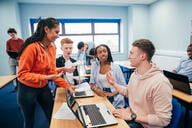You have /5 articles left.
Sign up for a free account or log in.
WASHINGTON -- The case for student evaluations of teaching is obvious: students are (hopefully) at each class session, with a front-row seat to the good, the bad and the ugly of instruction. They may also have clear goals about what they want from a course.
Yet the validity of formal, end-of-semester teaching evaluations by students is politically fraught and empirically challenged: advocates say well-designed evaluations work, while opponents say most questionnaires reveal more about student biases than teaching. There are concerns, too, about how students’ evaluations should inform high-stakes personnel decisions about faculty members, such as tenure and promotion.
What if there was a different way, entirely focused on improving instruction, with ancillary benefits to student evaluators? There is, and it works, says Alison Cook-Sather, Mary Katharine Woodworth Professor of Education and director of the Teaching and Learning Institute at Bryn Mawr and Haverford Colleges.
Cook-Sather was on hand here Thursday at the annual meeting of the Association of University Professors to talk about the “pedagogical partnership” program she’s established on her campuses, called Students as Learners and Teachers. She noted other kinds of institutions, including community colleges and public universities, have adopted similar initiatives.
Students as Learners and Teachers
“Students who are not enrolled in courses visit faculty members’ classes, take observation notes, meet with faculty weekly to talk about their teaching,” Cook-Sather said, explaining the partnership program in which 216 professors and 137 students have participated since its inception in 2006, thanks in part of a grant from the Andrew W. Mellon Foundation. “The student is not there to evaluate; they’re there to reflect back on what they see from the student’s perspective.”
Pedagogy-focused partnerships are between one instructor and one student not enrolled in the focal course, over the course of a year or semester. Students are compensated for their participation, either through stipends, work-study agreements or academic credit. They must apply for the program, but all are generally accepted, regardless of academic performance or other factors, as diversity of perspective is a deliberate goal.
Working through a central director, with whom they meet once a week, students visit their partner instructors’ classrooms weekly and take detailed notes about what they’ve observed. Did students know what was going on, for example? Did they seem engaged? It doesn’t really matter if student partners know anything about the course or discipline, and students have even observed courses in languages they don’t speak.
Student observers then meet with faculty partners weekly to discuss the observation. Principles underpinning these interactions, Cook-Sather said, are respect, reciprocity and a sense of shared responsibility. The student is not there to berate the instructor, and vice versa. They are, ideally, a team.
The program can also include curriculum-focused partnerships over a semester, in which faculty members and single students or groups of students who are not enrolled in the course at hand meet weekly or every other week to plan or revise the curriculum.
New professors may opt into the program but aren’t required to do so; Cook-Sather said it’s important that the partnership doesn’t “ossify” into something less worthwhile due to institutionalization or coercion. It’s also crucial that the program remain separate from promotion and tenure decisions, she said; professors can include notes from student partners in their files if they choose, but to make the program part of formal evaluation would corrupt its integrity.
The seed for the partnership program was a teacher-preparation program involving high school students years back. And the first iterations of the college-level program focused solely on improving instruction. But soon Cook-Sather saw new possibilities for students via their participation. Or, as she put it in a 2010 paper, “a more encompassing possibility: fostering in students a sense of and capacity for responsibility in ways that not only address existing educational ideals but that also point to both more transformative and more achievable notions of education and accountability than those currently in place.”
Affirming Students' Rights, Extending Their Responsibilities
Seven years (and a book on the topic) later, Cook-Sather is convinced that “pedagogical partnerships affirm students’ rights and extend their responsibilities,” which was, not coincidentally, the topic of her discussion Thursday. “The work that I’ve been doing in my practice and my research for about 20 years is really around how can students have more responsibility for their education, how can they take more responsibility for what happens in college classrooms and also when they’re not enrolled in those college classrooms.”
It’s admittedly “radical,” she said, especially in an era in which so many professors perceive a diminished role in the classroom, the university and academe more broadly. But, she argued, “this is really students and faculty each contributing to what happens in the classroom, but not in the same ways. Faculty bring a kind of expertise; students bring a very different kind of expertise. It’s not about delegitimizing faculty authority or expertise -- it’s really about bringing perspectives together.”
Both professors and students benefit from the program through increased engagement, metacognitive awareness and a stronger sense of identity, and improved classroom experience, Cook-Sather said, sharing the following comment from a student partner: “My preparation for and my discussions with my faculty partner have made me more self-reflexive about my own experience and responsibilities as a student.”
Here’s a comment from a faculty partner: “For the first time, I was able to get the sense of how others experienced the class. Her perspective gave her access to specific insights which I remained blind to: she alerted me to students’ confusion, affirmed and/or challenged my choices of activities, and helped me identify the pedagogical practices that worked, even for the most withdrawn students.”
Participation has notable outcomes for underrepresented students, Cook-Sather added, sharing one student’s expression of increased belonging and empowerment. “Being a student consultant gave me a voice as a person of color when I was not in the role of student consultant … by reinforcing that not only did my perspective, assessment skills and commitment to make spaces safer for underrepresented groups deeply matter -- they could drive important transformation in classrooms and in the student-teacher relationship.”
Co-Creating a Course
Beyond one-on-one pedagogical and curricular partnerships, Cook-Sather also co-creates a course called Advocating Diversity in Higher Education with students enrolled in it. She designed the framework for the class with a student from Students as Learners and Teachers, and now asks the class to help her steer it as it unfolds.
Students complete forms to talk about individual needs concerning access and how their differences or disabilities might be a resource to them or fellow students, in addition to a course commitment form. The latter, used as a self-assessment, lists all assignments and asks students how they wanted to complete them, and for what share of their grades.
Activities include a radical listening activity in which pairs of students discuss how they feel listened to, and a “gallery walk” of the results of students interviewing students on relevant course topics. Assignments included weekly shared readings from a lengthy reading list, a co-created annotated bibliography, “field work” of facilitated conversations and interviews, and a research project on challenges to diversity in higher education with executive summaries delivered to senior college staff members. There's also a final portfolio.
Students seem to enjoy the experience, based on their feedback. Here’s one comment: “This class has permanently altered the way I think and talk about diversity, higher education and the ways we define activism and advocacy. It’s impacted how I consider and navigate my whiteness in different spaces and without a doubt made me a better person and listener.”
Faculty members in the audience, too, seemed to like what Cook-Sather had to say Thursday, with several commenting that their campuses need this kind of student-faculty partnership. One professor of physics at a historically black institution said his university already had adopted such a practice, and that faculty participants benefit greatly in their promotion and tenure decisions. (In response, Cook-Sather underscored the importance of keeping partnerships separate from personnel decisions unless otherwise indicated by the instructor.)
One professor wondered doubtingly whether pedagogical partnerships could be replicated online, and Cook-Sather said the program does indeed highlight the importance of face-to-face student-faculty interaction. When another professor argued that such an adaptation could work, since so many courses that once seemed impossible to teach virtually are now online, Cook-Sather smiled and said, “You should start one online.”
Not a Replacement for Traditional Evaluations
Cook-Sather said after the session that students still fill out traditional course evaluations at the end of their courses, as is required at Bryn Mawr. But in her co-creation course, she said, she also gathers mid-term feedback from students.
As a result of the "ongoing dialogue" students "tell me that they feel far better able to complete those end-of-semester evaluations in a meaningful way," she said. Students also self-evaluate and assign themselves grades, she said, so various forms of reflection, assessment and evaluation "become intertwined and are, again, threads in an ongoing conversation based on respect and shared responsibility."
The program is a "tremendous amount of work for the students, and a different kind of work for me than a traditional course, but it is also, students tell me, among the most gratifying work they have done because they have so much agency and accountability not only to themselves and to me but also to one another," Cook-Sather said. "This form of co-creation is equally gratifying for me because I can provide the space, structure, challenge and support that allow individual and also collective deepening of understanding and capacity around what advocating diversity in higher education might mean."





